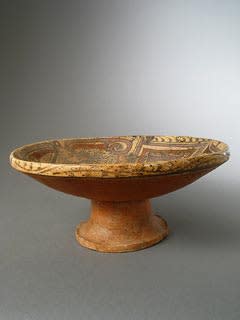Cocle Terracotta Polychrome Pedestal Bowl, 500 CE - 1000 CE
Terracotta
5.25
PF.4485
Further images
Archaeological excavations in the Cocle Province located in Central Panama have revealed that an ancient civilization once inhabited these lands. The findings suggested that the so-called Cocle culture arose around...
Archaeological excavations in the Cocle Province located in Central Panama have revealed that an ancient civilization once inhabited these lands. The findings suggested that the so-called Cocle culture arose around 500 A.D. and lasted until about 1000 A.D. Although their dating is roughly contemporaneous with the Diquis culture to the north in modern day Costa Rica, the art they left behind suggests that they were a unique, independent civilization. Cocle art, which consists primarily of unslipped or buff slipped pottery and terracotta sculptures, is distinguished by their polychrome hues and lively asymmetrical motifs which often include animal themes.
Around 800 A.D. a new style of pottery arose in Cocle known as Macaracas Red, black and purple/lavender lines on a buff- white background characterize it. In terms of imagery a predominant saurian (reptilian) motif appeared, along with mythical figures, both done in a highly abstract manner. The pattern on this very lovely bowl may first appear as a type of abstract painting. Actually it is, with the added element that the design has a meaning, which was understood by the people who owned this bowl centuries ago. We see two mythic figures facing each other as if in a mirror. Their heads are triangles, their bodies serpentine, twisting and curling towards the center where they are joined by two straight lines of red and purple. Both figures have their hands raised and are identical with the exception of one has a red instead of purple arm. Their fingers are multiple talons, which curl outwards as if reaching for something. These characters probably represent a Shaman portrayed in the state of transforming himself into a spiritual being; an accomplishment the Shamans of ancient times were reputed to be able to do. This beautiful vessel is like a perfect element of nature; a flower held against the light with its intricate patterns weaving in and out of the physical and non-physical worlds.
Around 800 A.D. a new style of pottery arose in Cocle known as Macaracas Red, black and purple/lavender lines on a buff- white background characterize it. In terms of imagery a predominant saurian (reptilian) motif appeared, along with mythical figures, both done in a highly abstract manner. The pattern on this very lovely bowl may first appear as a type of abstract painting. Actually it is, with the added element that the design has a meaning, which was understood by the people who owned this bowl centuries ago. We see two mythic figures facing each other as if in a mirror. Their heads are triangles, their bodies serpentine, twisting and curling towards the center where they are joined by two straight lines of red and purple. Both figures have their hands raised and are identical with the exception of one has a red instead of purple arm. Their fingers are multiple talons, which curl outwards as if reaching for something. These characters probably represent a Shaman portrayed in the state of transforming himself into a spiritual being; an accomplishment the Shamans of ancient times were reputed to be able to do. This beautiful vessel is like a perfect element of nature; a flower held against the light with its intricate patterns weaving in and out of the physical and non-physical worlds.





